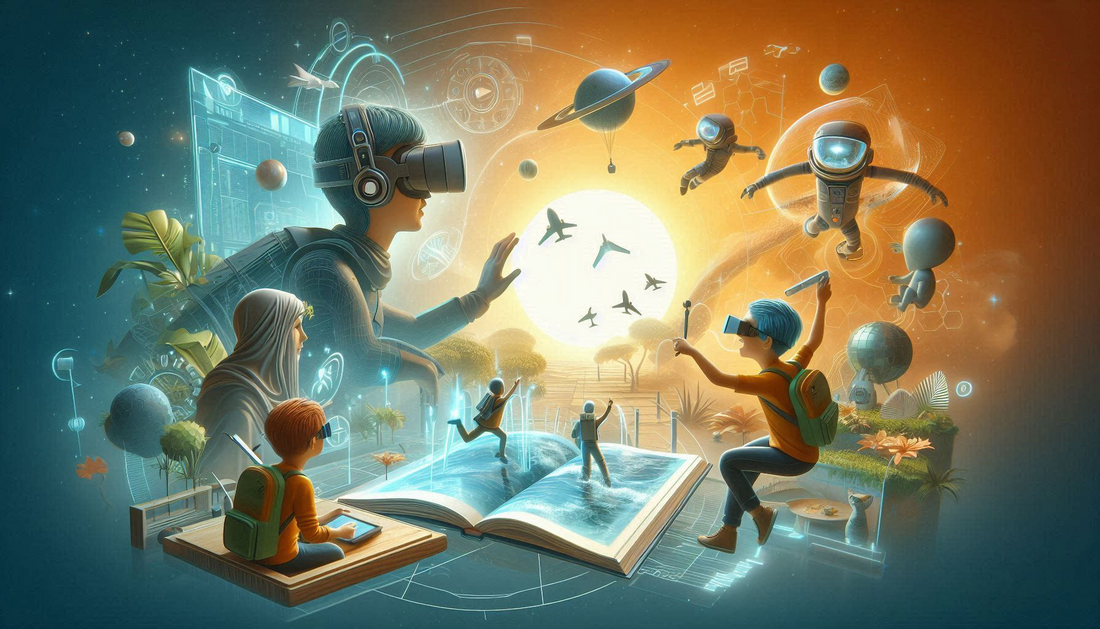
Making Learning More Fun: The Impact of VR in Education
Share
Introduction
The old way of learning in a classroom with a board, books, and a teacher is changing. Technology is making learning more engaging and fun. Virtual Reality (VR) is leading this change, making education more interactive and enjoyable.
What is Virtual Reality?
Virtual Reality (VR) is a way to experience a fake world that feels real. It's like a super-advanced video game! You wear a special headset or use a device to see all around you in 3D. This lets you explore and interact with the virtual world in a really immersive and lifelike way. It's like you're really there!
The Impact of VR in Education
Virtual Reality (VR) is transforming the education sector in exciting ways, making learning more enjoyable, effective, and accessible. By providing an immersive experience, VR is helping students understand complex concepts better and making learning more fun. Additionally, VR is breaking geographical barriers, reaching more students and making quality education available to everyone
- Enhanced Engagement
Virtual Reality (VR) makes learning more enjoyable and exciting for students. It helps keep them interested and motivated, leading to a better learning experience. With VR, students can interact with complex ideas in a more hands-on and engaging way, like a game! This encourages them to participate and explore, making learning feel less like a chore.
- Improved Retention
Virtual Reality (VR) helps students remember what they learn better. Studies show that VR can improve memory by up to 80%! By making learning interactive and fun, VR helps students recall complex ideas and information more easily. This means they retain what they learn, making it a powerful tool for education!
- Personalized Learning
Virtual Reality (VR) is a game-changer for personalized learning. It lets teachers create unique learning experiences that fit each student's individual needs and learning style. This means students can learn in a way that works best for them, whether they're visual, auditory, or hands-on learners..
- Increased Accessibility
Virtual Reality (VR) is breaking down barriers to education. It helps make learning available to students with disabilities, those living in remote or rural areas, and those who can't afford traditional educational resources. By making learning experiences easy to share and access, VR is bridging the educational gap and making it possible for everyone to learn and succeed.
- Cost-Effective
Virtual Reality (VR) is making education more affordable for everyone. By using VR, schools can save money on expensive field trips, equipment, and travel costs. Instead, VR experiences can be easily repeated and shared with students, providing the same learning benefits at a fraction of the cost
- Real-World Applications
Virtual Reality (VR) is helping students prepare for their future careers and challenges. By providing real-world applications and experiences, VR lets students see how what they're learning applies to the world outside the classroom. Through simulated scenarios, students can practice and develop essential skills and knowledge, getting them ready for what's next.
Examples of VR in Education
- Medical Training: VR lets medical students practice surgeries and patient care in a safe and simulated environment.
- Language Learning: VR puts language learners in a virtual world where they can practice conversations and interactions.
- Historical Reenactments: VR brings history to life by recreating past events, making learning more fun and interactive.
- Science Experiments: VR lets students do science experiments safely and virtually, without any risks or mess.
Challenges and Limitations
While VR can greatly improve education, there are some challenges to consider:
- Cost: Good VR equipment and content can be pricey.
- Technical Problems: Technical issues can ruin the VR experience.
- Limited Content: There's not enough educational VR content available yet.
- Teacher Support: Teachers need help learning how to use VR in their teaching.
These challenges need to be addressed to make VR a success in education.
A Bright Future for VR in Education
The future of VR in education looks great! As technology improves, we can expect:
- More Schools Using VR: VR will become a common tool in schools and educational institutions.
- Better Content: More high-quality educational VR content will be available for students.
- New Features: Advanced features like augmented reality and artificial intelligence will enhance VR experiences.
Conclusion
Virtual Reality (VR) is making learning more enjoyable, interactive, and engaging. Although there are some challenges, the advantages of VR in education are clear. As VR technology improves, we can expect to see new and innovative ways to learn, leading to a more exciting, effective, and inclusive education for everyone.
